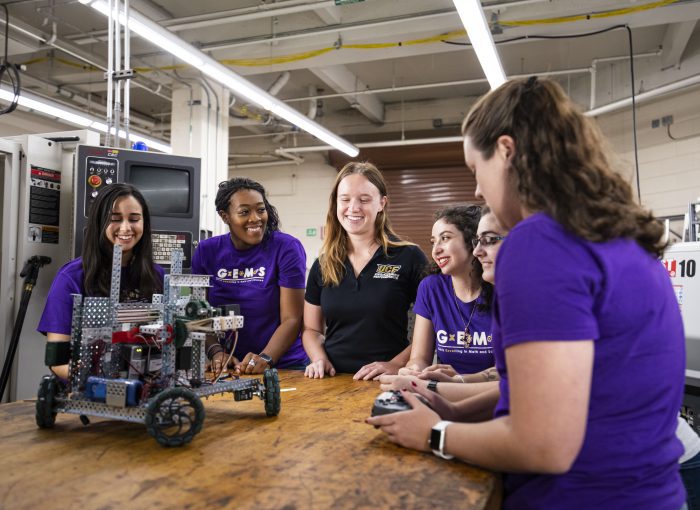By Rebecca Vollmann
The presence of a diverse and inclusive workforce is evident in many career fields, but lacking in others, such as science, technology, engineering, and math (STEM). The value of diversity is unquestionable, but some may find it hard to relate to. Oftentimes, those who do not see the value of diversity merely have not experienced the harm marginalized populations face when diversity is lacking. Perpetuating a lack of diversity in key industries does serious damage. Not only does this cycle hinder social progress, but it stagnates STEM industry progress as we usher new advancements into the age of technology.

As a woman in STEM, I have been asked countless times if I believe I am where I am today because of diversity hiring and gender equality initiatives. The question alone makes me second-guess myself, something I have been doing all my life. I am first-generation American, first-generation college student, and part of a small number of women in my engineering classes; lots of firsts with little to no plan laid out for me to guide me through my decision to pursue a career in a male-dominated industry. While I would like to think I have solely earned my stature due to my own accomplishments, I cannot deny the effect of diversity initiatives on my own ventures within academia and career. Was I selected for impressive jobs just to meet a workforce gender ratio? Did I obtain prestigious research positions to make the team look more diverse? Simply put, no.
I worked hard to constantly prove myself in my endeavors and consistently outperform my male counterparts. I have displayed a level of creativity and unique mindset that I do not often see in STEM, something I definitely can blame lack of diversity on. Challenges require inspired solutions; thus, it would make sense to believe that someone who has overcome more challenges may also have a better approach to problem-solving, which is the heart at all STEM disciplines.
So, what role does diversity play in STEM? “Diversity exists in STEM, but it gets diluted at higher levels,” says Mohsina Mahmood, a third-year mechanical engineering student and member of UCF’s Society of Women Engineers (SWE). Mahmood points out that women account for only a small number of specialist engineers, and even fewer women of color are represented. She said the same is true of representation in higher education. The majority of bachelor’s degrees earned every year are awarded to women; however, women earned only 36% of bachelor’s degrees in STEM in 2015. This trend continues into graduate studies and the workforce.
There are few non-white, female, disabled or LGBTQ+ CEOs in engineering, so the resounding struggles of minority students are not understood, especially at a level of leadership.
Less than 30% of the world’s working researchers are women, and women only make up 43% of scientists and engineers in the U.S. workforce. This statistical data brings a harsh reality to light: the further women go into STEM, the more difficult it is for them to retain their status or be promoted in comparison to their male colleagues. There are further marginalized populations when delving into race, religious preference, disability status, and sexual orientation, but little data exists on representation of those groups in STEM, highlighting the apparent minimization of these groups’ presence. If hardly any data exists, it can be assumed that it is something that the majority of STEM community does not care about, which pains me to think about. The issue with that is that this community is predominantly white males and thus comes with an associated privilege, unaware of the hardships of marginalized peoples.
Because the STEM student body and labor force are less diverse, an archetype forms of the scientist or engineer being predominantly white and male. This archetype becomes difficult for non-white, non-male students to connect to, as it does not reflect their lived experiences. For example, there are few non-white, female, disabled or LGBTQ+ CEOs in engineering, so the resounding struggles of minority students are not understood, especially at a level of leadership. Only 5.5% of engineering managers are female and less than 15% are a race other than white, according to the Bureau of Labor Statistics.

Why is diversity only minimally present in STEM? “Diversity in STEM seems to exist only in a capacity that is marketable” says a student who asked to remain anonymous in UCF’s chapter of the National Society of Black Engineers (NSBE). The Civil Rights Act, passed in 1964, prevents discrimination in education and workplaces. Forty states still uphold affirmative action. So, the question is this: What is preventing diversity in STEM?
While there are many factors that contribute to the minimally diverse population in STEM, a prominent opinion held within the community seems to be that diversity holds no value and thus “diversity hires” only serve to award potentially less-deserving candidates these jobs that may have been better filled by candidates that do not have any defining diverse characteristics. This is simply not true. The movie Hidden Figures that came out in 2016 showcased the story of Katherine Johnson and other women of color who served as engineers and scientists at NASA in the ‘60s. These women were pioneers for diversity in STEM. The movie’s storyline teeters on the what ifs of America’s astronautical program and its position in the Space Race if it had not been for the integration of diverse teams at NASA.
Students in UCF’s Society of Hispanic Professional Engineers (SHPE) know this struggle all too well. Jazmine Manriquez, a junior Industrial Engineering major says that “to persevere in STEM as a minority, we must find individuals striving for the same goal and work twice as hard to achieve it.” She then makes the point that since many of these minority students are charting new territory in their families, they do not have the same resources other students may have. Among all undergraduate students, the Department of Education classified 25% of white and Asian-American students as first-generation students. In contrast, 41% of African American and 61% of Latino students belong to this demographic. When students are forced to have to “check diversity boxes” to validate their experience and overcoming of hardships, it discourages them and further enables this filtering of diverse peoples out of STEM.
Now, take a moment. Pause for 30 seconds and imagine a scientist. Lab coat, safety goggles, test tubes and all. What race is your imaginary scientist? Is it a man? If so, don’t feel discouraged. A viral experiment titled “Picture A Scientist” suggests biases are subconsciously ingrained during childhood. Students as young as first grade were asked to imagine a scientist and draw what appeared in their minds. This experiment has been recreated over and over, and the majority of children in every study drew a white male. The children could not answer why they did not draw the scientist as female, African American, disabled or having a defining physical characteristic that set them apart from a white male. With this study in mind, it becomes increasingly difficult to deny the thought that this bias is anything but systemic. “If someone different than you makes you uncomfortable, you should question why diversity makes you uncomfortable and where that prejudice may come from,” says a student who asked to remain anonymous from UCF’s Out in STEM club (oSTEM). These biases, conscious or not, shape young minds and influence lives. They set some up for failure and push others to perpetuate the cycle of discrimination.
There is a long way to go, but I know we are headed in the right direction.
However harrowing this portrait of diversity may be, I know that it is slowly being turned around by community activists as well as company and school initiatives. Our generation has set out to identify and eliminate the qualitative factors that deter minorities from pursuing STEM. Many universities, like UCF, have organizations to encourage a robust student population, including SWE, NSBE, SHPE, and oSTEM. The College of Engineering and Computer Science has its own task force to bring awareness to the cost of a non-inclusive student body. There are also mentoring programs like Girls Excelling in Math and Science (GEMS) and Women in Science and Engineering (WISE) have been proven to increase retention of women in these fields. Setting everyone up for success, regardless of race, gender, ability, or sexual preference, is the first step in correcting the systemic biases in STEM. There is a long way to go, but I know we are headed in the right direction.




